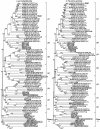Multiple groups of endogenous betaretroviruses in mice, rats, and other mammals
- PMID: 15140976
- PMCID: PMC415799
- DOI: 10.1128/JVI.78.11.5784-5798.2004
Multiple groups of endogenous betaretroviruses in mice, rats, and other mammals
Abstract
Betaretroviruses exist in endogenous and exogenous forms in hosts that are widely distributed and evolutionarily distantly related. Here we report the discovery and characterization of several previously unknown betaretrovirus groups in the genomes of Mus musculus and Rattus norvegicus. Each group contains both mouse and rat elements, and several of the groups are more closely related to previously known betaretroviruses from nonmurine hosts. Some of the groups also include members from hosts which were not previously known to harbor betaretroviruses, such as the gray mouse lemur (Microcebus murinus) and Seba's short-tailed bat (Carollia perspicillata). Some of the mouse and rat elements possess intact open reading frames for gag, pro, pol, and/or env genes and display characteristics of having retrotransposed recently. We propose a model whereby betaretroviruses have been evolving within the genomes of murid rodents for at least the last 20 million years and, subsequent to (or concomitant with) the global spread of their murid hosts, have occasionally been transmitted to other species.
Figures




References
-
- Baust, C., G. J. Baillie, and D. L. Mager. 2002. Insertional polymorphisms of ETn retrotransposons include a disruption of the wiz gene in C57BL/6 mice. Mamm. Genome 13:423-428. - PubMed
-
- Boeke, J. D., and J. P. Stoye. 1997. Retrotransposons, endogenous retroviruses, and the evolution of retroelements, p. 343-435. In J. M. Coffin, S. H. Hughes, and H. E. Varmus (ed.), Retroviruses. Cold Spring Harbor Laboratory Press, Cold Spring Harbor, N.Y. - PubMed
Publication types
MeSH terms
LinkOut - more resources
Full Text Sources
Other Literature Sources

